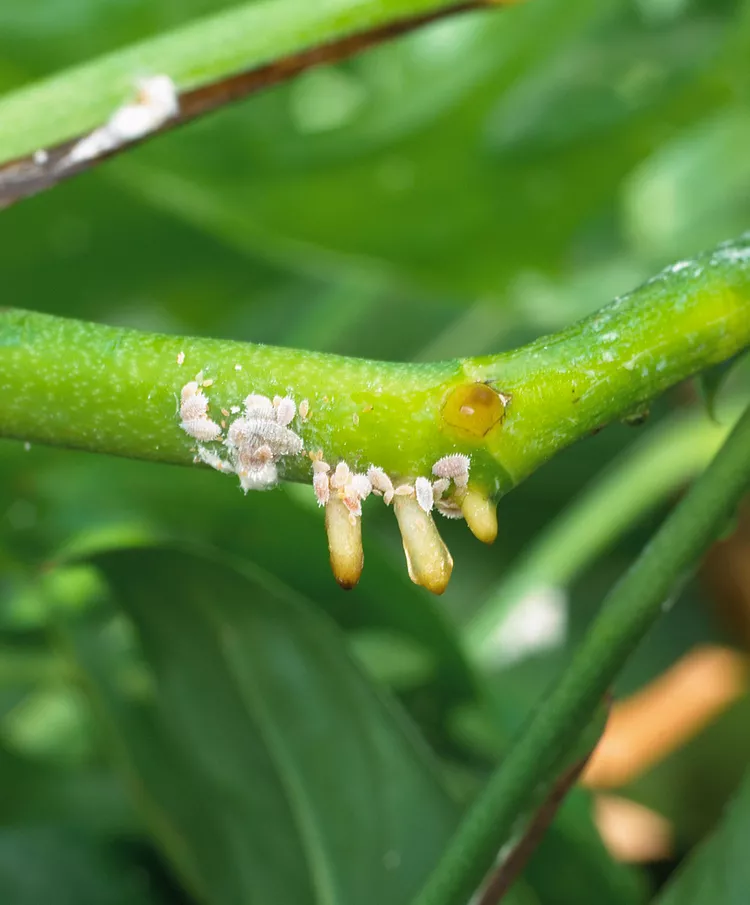Every once in a while, you're bound to get a few bugs on your houseplants. One of the most common pests you're likely to encounter is the mealybug. These insects look like tiny bits of waxy or fuzzy white cotton stuck on stems and leaves. Mealybugs almost look cute (as far as insects go), but they're actually a triple threat when it comes to your houseplants. First, the pests suck juice from plants, which weakens and damages growth. Mealybugs also leave an annoying, sticky residue of undigested sugar, known as honeydew. That sticky mess can allow a fungus called sooty mold to grow, reducing a plant's access to sunlight. Here's how to get rid of mealybugs on your houseplants and keep the pests from coming back.
What Are Mealybugs?
Mealybugs are tiny, oval-shape insects related to scale (another plant pest), but they have soft bodies instead of a hard shell like scale does. Look for them in hard-to-reach spaces, such as the points where leaves meet stems and the undersides of leaves. Some mealybugs also hide in soil and on roots, making them more challenging to spot. These insects are most attracted to citrus trees and tropical plants such as fiddle leaf figs and hibiscus, but they're not too picky. Mealybugs can spread to other nearby plants, too.
How to Get Rid of Mealybugs
When you need to get rid of mealybugs on your houseplants, patience and persistence are important. First, isolate the infested plant or plants so the bugs don't get a chance to spread further. Then, take a closer look to figure out how bad the problem is because this will help you decide how to deal with the pests.
Dab Them With Rubbing Alcohol
If the infested plant is small or there aren't many mealybugs, dab the insects with a cotton swab soaked in rubbing alcohol. This will kill and wipe off the bugs, as well as clean away the honeydew. The alcohol will dry quickly without hurting your plant, but it's always a good idea to test a leaf and wait a day to see how each plant responds.
Spray Them With Jets of Water
You can also remove mealybugs from your houseplants with a strong jet of water. Take your potted plants outside (as long as temperatures are above 50˚F) and use your hose to spray them down. Don't forget to hit the undersides of leaves. In addition to blasting off the bugs, you'll also be rinsing away any sticky residue, and cleaning off dust and dirt. However, this method isn't a good choice for delicate plants or those that don't like a lot of water.
Try Insecticide
For the most stubborn mealybug infestations, using insecticidal soap or neem oil should do the trick. Spray thoroughly over all the white patches on your plant, making sure to get into the stem crevices and under leaves. As with any pesticide, always read and follow all instructions on the label to effectively and safely use these products. Repeat the treatment of choice every few days until there are no signs of pests.
Toss Your Infected Plants
Sometimes, mealybugs will infest your plants' roots, and it's nearly impossible to completely eliminate the pests then. In this case, the easiest thing to do would be to toss the plant to keep the pests from spreading to your other plants.
Tips for Preventing Mealybug Infestations
- Mealybugs can hitchhike when you buy a new plant or move your houseplants back indoors for the winter. These are both good times to check the plants very carefully before you bring them into your home.
- For new plants, it's a good idea to quarantine them away from your other plants for a week or two. That way, if any bugs or diseases do manage to sneak in, you'll keep them from spreading out of control.
- Avoid overwatering or over-fertilizing your plants because this can draw mealybugs to them. It's best to keep your plants well-drained and keep the area around them clean.




















